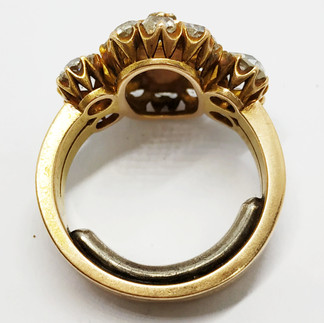Fabergé Ring Sold On Alma Auctions
- alma alma
- Nov 26, 2022
- 2 min read
From Imperial Legacy to Auction Triumph: Michael Perchin's Fabergé Ring Commands $20,000

"From Imperial Legacy to Auction Triumph: Michael Perchin's Fabergé Ring Commands $20,000"
In the captivating tapestry of Russian Imperial history, a chapter unfolds through the hands of Fabergé's master craftsman, Michael Perchin, during the reign of Alexander III (1881-1894). The spotlight falls on an extraordinary 14-karat rose gold, diamond, and enamel ring, a unique creation of prodigious size that echoes the opulence of its era.
Imperial Relic with Royal Symbolism
This imperial relic bears a central blue enameled plaque adorned with the royal cipher "A III" and the imperial Russian crown—a symbol of regal authority and a cherished emblem to the Tsar. The centerpiece holds four old European cut diamonds, totaling approximately 3.50 carats, surrounded by a halo of 12 additional old European cut diamonds, adding a further 2.50 carats. The grandeur of the total carat weight reaches an impressive 6 carats, making this ring a true masterpiece.
Craftsmanship and Symbolism
Executed by Michael Perchin for Fabergé, the ring is not only a display of craftsmanship but a unique symbol with a faded but distinguishable hallmark, "M.N." Its color graded at E-F and clarity ranging from VVS2-SI1 (with most diamonds falling into the VS category) attests to its exceptional quality. Stamped with the Russian 18K hallmark and the St Petersburg city mark, the 17.1-gram ring, with an original soldered sizing bar, proudly carries a ring size of 8.
Auction Triumph and Historical Significance
Despite its very good general condition, showcasing a bit of wear on the enamel and a missing small diamond in the center of the "crown," this imperial treasure recently took the auction stage at Alma Auction House in Tel Aviv. What began as a modest valuation of $4,000 transformed into a riveting bidding war, culminating in a triumphant sale at $20,000. The exclusive transaction, facilitated through bank transfer, adds an extra layer of prestige to the possession of this historical gem.
A Living Artifact of Russian Imperial History
As a ring bearing the cypher of the Sovereign, it harks back to a tradition dating to the late eighteenth century. However, its use became more frequent during the nineteenth century, under the reign of Emperor Nicholas I, with stringent requirements dictating the granting of such extravagant rings. This particular piece stands not just as a testament to an era gone by but as a living artifact, embodying the elegance, tradition, and decadence of Russian Imperial history.














Comments